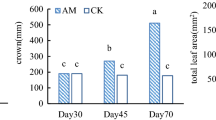Abstract
NUMEROUS observers must have noted in crops of mangels that, attached to portions of the storage organs of these plants, well above soil-level, were numerous lateral roots, hanging in the air and having no contact with the soil. Other lateral roots though still embedded in the soil may have their point of origin several inches above soil-level. Percival1 points out that in some varieties of mangels the hypocotyl grows up out of the ground. Upward growth of the hypocotyl will not, however, elevate above the soil lateral roots which arise below the level at which the seed was sown. In fact, it is clear in many cases that these lateral roots are raised by the upward growth of the true main root.
This is a preview of subscription content, access via your institution
Access options
Subscribe to this journal
Receive 51 print issues and online access
$199.00 per year
only $3.90 per issue
Buy this article
- Purchase on Springer Link
- Instant access to full article PDF
Prices may be subject to local taxes which are calculated during checkout
Similar content being viewed by others
References
“Agricultural Botany”, London (1910).
Author information
Authors and Affiliations
Rights and permissions
About this article
Cite this article
WARNE, L. Growth of Mangels and Long Beet. Nature 165, 29–31 (1950). https://doi.org/10.1038/165029a0
Issue Date:
DOI: https://doi.org/10.1038/165029a0
Comments
By submitting a comment you agree to abide by our Terms and Community Guidelines. If you find something abusive or that does not comply with our terms or guidelines please flag it as inappropriate.



